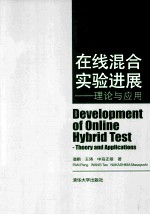图书介绍
在线混合实验进展 理论与应用 英文PDF|Epub|txt|kindle电子书版本网盘下载

- 潘鹏,王涛,中岛正爱著 著
- 出版社: 北京:清华大学出版社
- ISBN:9787302335412
- 出版时间:2013
- 标注页数:211页
- 文件大小:32MB
- 文件页数:222页
- 主题词:建筑结构-防震设计-实验方法-英文
PDF下载
下载说明
在线混合实验进展 理论与应用 英文PDF格式电子书版下载
下载的文件为RAR压缩包。需要使用解压软件进行解压得到PDF格式图书。建议使用BT下载工具Free Download Manager进行下载,简称FDM(免费,没有广告,支持多平台)。本站资源全部打包为BT种子。所以需要使用专业的BT下载软件进行下载。如BitComet qBittorrent uTorrent等BT下载工具。迅雷目前由于本站不是热门资源。不推荐使用!后期资源热门了。安装了迅雷也可以迅雷进行下载!
(文件页数 要大于 标注页数,上中下等多册电子书除外)
注意:本站所有压缩包均有解压码: 点击下载压缩包解压工具
图书目录
CHAPTER 1 Introduction1
1.1 Background,objective,and challenge1
1.2 Organization5
REFERENCES9
CHAPTER 2 Basics of Time Integration Algorithms12
2.1 Introduction12
2.2 Principle of time integration algorithms and properties12
2.3 Development of time integration algorithms13
2.3.1 Linear multi-step methods13
2.3.2 Newmark's family methods14
2.3.3 Collocation methods15
2.3.4 α-family methods15
2.3.5 ρ-family methods16
2.3.6 Mixed implicit-explicit methods16
2.4 Numerical characteristics analysis of time integration algorithms17
2.4.1 Spectral stability17
2.4.2 Accuracy analysis18
2.5 Conclusions20
REFERENCES20
CHAPTER 3 Typical Time Integration Algorithms23
3.1 Introduction23
3.2 Analysis of typical time integration algorithms23
3.2.1 Central difference method23
3.2.2 Newmark's method24
3.2.3 Hilber-Hughes-Taylor(HHT)-α method26
3.2.4 Generalized-α method28
3.2.5 Implicit-explicit method29
3.2.6 Modal truncation technique30
3.2.7 Integral form of existing algorithms32
3.2.8 State space procedure32
3.3 Applications for online hybrid test(pseudodynamic test)34
3.3.1 Applications of central difference method35
3.3.2 Hardware-dependent iterative scheme36
3.3.3 Newton iterative scheme based on HHT-αmethod37
3.3.4 α-operator-splitting(OS)method38
3.3.5 Predictor-corrector implementation of generalized-α method(IPC-ρ∞)39
3.3.6 Ghaboussi predictor-corrector method40
3.4 Conclusions41
REFERENCES41
CHAPTER 4 Online Hybrid Test Using Mixed Control44
4.1 Introduction44
4.2 Presentation of the online test system45
4.2.1 Loading system45
4.2.2 Base-isolated structure model48
4.2.3 Test Setup50
4.3 Displacement-force Combined control52
4.3.1 Static test for combined control52
4.3.2 Algorithm of online test using displacement-force combined control54
4.3.3 Online test using displacement-force combined control55
4.4 Force-displacement switching control59
4.4.1 Static test for displacement-force switching control59
4.4.2 Algorithm of displacement-force switching control60
4.4.3 Online test using displacement-force switching control62
4.5 Conclusions64
REFERENCES65
CHAPTER 5 Internet Online Hybrid Test Using Host-Station Framework67
5.1 Introduction67
5.2 Presentation of the Internet online test system69
5.2.1 System framework69
5.2.2 Internet data exchange interface71
5.3 Accommodation with implicit finite element program77
5.3.1 Importance of stiffness prediction77
5.3.2 Proposed prediction method77
5.4 Internet online test of base-isolated structure78
5.4.1 Base-isolated structure model79
5.4.2 Test setup and test specimen80
5.4.3 Test Results82
5.5 Conclusions85
REFERENCES86
CHAPTER 6 Intemet Online Hybrid Test Using Separated-Model Framework88
6.1 Introduction88
6.2 Development of separated-model framework89
6.2.1 Design of separated-model framework89
6.2.2 System implementation91
6.2.3 High-speed data exchange scheme using socket mechanism93
6.2.4 Incorporation of finite element programs using restart capability95
6.3 Preliminary investigations of separated-model framework99
6.3.1 Seismic simulation of an one-story braced frame99
6.3.2 Seismic simulation of a three-story braced frame102
6.4 Distributed online hybrid test on a base-isolated building106
6.4.1 Prototype structure107
6.4.2 Numerical simulation of superstructure108
6.4.3 Specimen for base isolation layer109
6.4.4 Specimen for retaining walls111
6.4.5 Test environment design111
6.4.6 Elastic properties of structure112
6.4.7 Pushover analysis113
6.4.8 Quasi-static test113
6.4.9 Earthquake response simulation114
6.4.10 Time efficiency of experiment116
6.5 Conclusions118
REFERENCES119
CHAPTER 7 Internet Online Hybrid Test Using Peer-to-Peer Framework121
7.1 Introduction121
7.2 Development of peer-to-peer(P2P)framework122
7.2.1 Design of P2P framework122
7.2.2 Iteration by quasi-Newton method124
7.2.3 P2P Internet onlinehybrid test scheme127
7.2.4 Incorporation of general-purpose finite element(FEM)program130
7.3 Verification test of base-isolated structure131
7.3.1 Structure model and substructuring131
7.3.2 Internet online hybrid test environment134
7.3.3 Test setup and test specimen135
7.3.4 Test results137
7.4 Convergence criteria on P2P Internet online hybrid test system involving structural Nonlinearities142
7.4.1 Introduction142
7.4.2 Investigation of convergence criteria and tolerance143
7.4.3 Examination on type of divisions into substructures150
7.4.4 Number of degrees of freedom on boundaries152
7.4.5 Investigation on initial stiffness153
7.4.6 Summary156
7.5 Numerical characteristics of P2P predictor-corrector procedure157
7.5.1 Introduction157
7.5.2 Recursive matrix of two-round quasi-Newton test scheme158
7.5.3 Stability characteristics160
7.5.4 Accuracy characteristics160
7.6 Conclusions162
REFERENCES164
CHAPTER 8 Application of online hybrid test in engineering practice168
8.1 Introduction168
8.2 Application example of conventional online hybrid test168
8.2.1 Project brief168
8.2.2 Prototype and substructures169
8.2.3 Dynamics of the retrofitted structure170
8.2.4 Configuration of the hybrid test system171
8.2.5 Loading scheme172
8.2.6 Input ground motions and intensity173
8.2.7 Measurement scheme174
8.2.8 Test results174
8.3 Application example of P2P Internet online hybrid test175
8.3.1 Project brief175
8.3.2 Target Structure176
8.3.3 Substructures178
8.3.4 Improved test scheme of P2P framework179
8.3.5 Numerical analyses by P2P framework180
8.3.6 Distributed test environment181
8.3.7 Implementation of tested substructures182
8.3.8 Distributed test183
8.3.9 Verification of P2P framework184
8.3.10 Efficiency of P2P framework186
8.3.11 Practical evaluation of collapse limit of the frame187
8.3.12 Complex behavior of column bases188
8.4 Conclusions191
CHAPTER 9 Summary and Conclusions193
9.1 Summary and conclusions193
9.2 Time integration algorithms195
9.3 Online hybrid test using mixed control196
9.4 Internet Online Hybrid Test Using Host-Station Framework197
9.5 Separated-model framework and its demonstration examples197
9.6 Peer-to-peer framework and its preliminary demonstration test199
9.7 Application of online hybrid test in engineering practice201
APPENDIX Ⅰ List of Exiting Time Integration Algorithms203
APPENDIX Ⅱ Implementation of OS Method207